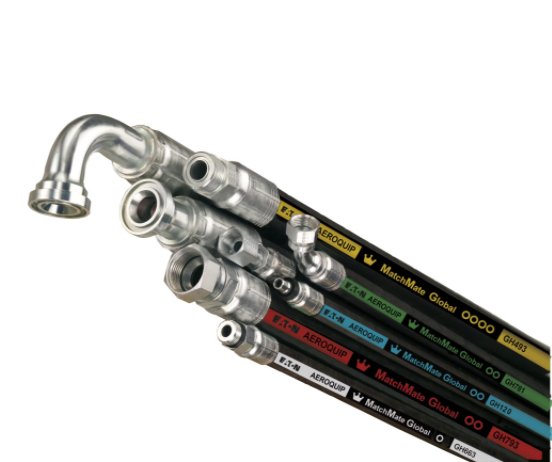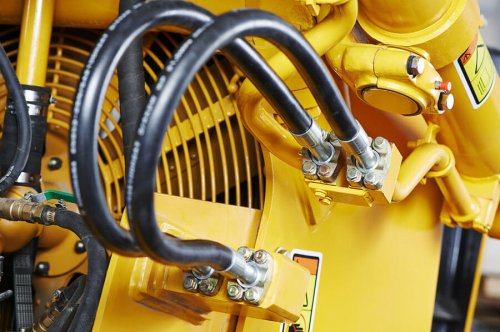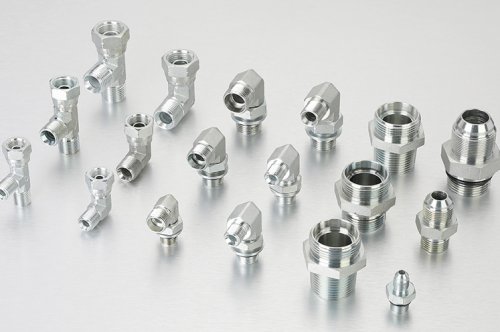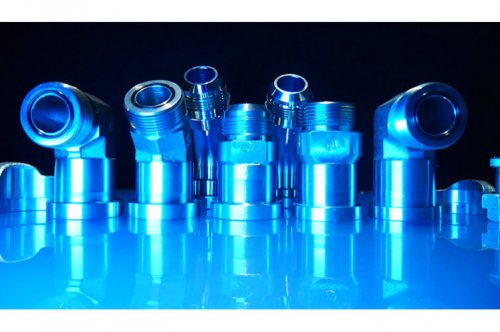Fittings and Flanges for Hydraulic Hose Use

There are many things that hydraulic systems have in common, including hydraulic hoses that connect to pumps, motors, valves, and cylinders. These joint connections must not only seal in pressurized hydraulic fluid but also seal out contamination and maintain the connection even in the presence of vibration and shock loadings. Two of the most commonly used categories of hydraulic hose connectors are fittings and flanges, and to choose the right ones for your systems, you need to understand how they differ and where they work best.
Fittings vs. Flanges: What’s the Difference?
Fittings and flanges are both joints used to connect hoses to other components within a hydraulic system. They are also both designed to be removable (i.e., they are not permanent connections unless you want them to be), allowing a hydraulic system to be repaired or maintained with ease. However, this is where their similarity ends.
The major difference between them is how they achieve an effective seal. In a fitting, the connection and seal are achieved by tightening threads between the mating halves; a flange, on the other hand, achieves the connection by bolting together the flanges on two mating halves. They also differ significantly in how they achieve the seal. Because of their basic difference in design, they are not always suitable for the same types of operating conditions.
Hydraulic Hose Fittings

The two main types of fittings are all-metal or O-ring. In an all-metal connection, the seal against pressurized fluid is made possible by metal-to-metal contact, while an O-ring hydraulic hose fitting forms a pressurized seal by compressing the O-ring between the two mating halves. All hose fittings, however, have tapered threads. They utilize the stress that is generated from forcing the tapered threads of both fitting halves together to achieve a reliable seal. In addition, they are considered mechanical joints.
All-Metal Fittings
There are two basic categories of all-metal fittings: flare fittings and flareless fittings. Flare fittings are a subcategory of all-metal fittings and are an improvement over traditional fittings. When the nut on a flare fitting is tightened, it draws the fitting into the flared end of the hydraulic hose and the result is a very strong seal. These fittings are best used when the hydraulic hose is thin to medium-walled and perform well in the presence of operating pressures up to 3 ksi.
There are also flareless fittings, which are not quite as commonly used in the United States. These all-metal fittings use ferrules instead of flares, which modifies to some degree how the seal is achieved. As the nut is initially tightened, the ferrule will contact the outer circumference of the hydraulic hose. When the nut is tightened further, the ferrule begins to actually penetrate the outer circumference of the hydraulic hose. Flareless fittings have the same recommended operating conditions as flare fittings.
O-Ring Fittings
Most all-metal fittings are prone to leaks — unless you opt for an O-ring fitting. In these fittings, an O-ring seal is used to increase the leak resistance of a fitting.
The two common types of O-ring fittings are boss fittings and FFOR (face seal or flat-face O-ring fittings). Boss fittings have an O-ring seated securely on the male side of the connector between the threads and wrench flats. When the fitting is tightened, that O-ring is compressed and the result is a pressure-resistant, leak-tight seal against the female port.
In an FFOR fitting, the O-ring is held in a recessed circular groove on the male side and a seal is formed between the female half and that O-ring. The O-ring is compressed between the two sides when the captive threaded nut is turned, thus achieving a highly effective seal.
Benefits of Hydraulic Hose Fittings

O-ring fittings have a significantly reduced probability of leaks compared to all-metal fittings because of the sealing effects of compressing the O-ring that occurs when the male and female sides make contact. In addition, O-ring fittings are much less susceptible to the effects of vibration and temperature change. Hydraulic hose fittings, in general, are very easy to assemble (and disassemble) in tight quarters as long as the hoses have an OD < 1”.
Hydraulic Hose Flanges
The typical hose flange has four parts: the flange head, the flange clamp, an O-ring, and bolts. The bolts are placed through the flange clamp and either pass into tapped holes on the flat surface of the flange head or two flanges may be bolted together. As the bolts are tightened, the flange head compresses the O-ring (which is contained within a groove) against the flat surface of the port, forming a leak-proof seal. If two flanges are bolted together, the O-ring or gasket will be located between the two surfaces in contact.
Hose flanges are typically categorized based on the number and arrangement of the bolts. The most commonly used are rectangular 4-bolt flanges (SAE Code 61 and 62 flanges, which can handle 5 ksi to 6 ksi respectively, and Caterpillar flanges) and square 4-bolt flanges. There are also a wide variety of custom arrangements and OEM-specific flanges. Additionally, split flanges can be installed on existing systems fairly easily.
Benefits of Flanges
Flanges make it much easier to connect hoses without requiring an adapter and their design makes them extremely resistant to loosening even in severe work environments. In addition, they can be assembled in areas with very limited space and do not require excessive torque to achieve a secure connection, unlike problems often encountered with fittings.
What Should You Use?

Fittings are most effective for smaller hose diameters ( < 1” OD). They are also easy to install on smaller hoses because large hoses require a significant amount of torque to achieve a secure connection. All-metal fittings will work well as long as there is sufficient space for the technician to install them. However, if vibration or higher pressures are present, then the best option is likely to be an O-ring fitting, which also happens to be easier to install.
Flanges, on the other hand, work best for larger size hoses (> 1” OD) that are going to be exposed to severe forces that can include high pressures, vibration, and shock loadings. They are also ideal for installation in areas where there is not enough swing clearance for a wrench.
Materials Used in Fittings and Flanges
Materials used in any kind of hydraulic connection need to be strong, durable, and resistant to corrosion (although this may be achieved through plating). That is why you will see the vast majority of fittings made from metal such as stainless steel, brass, aluminum alloys, and carbon steel. The choice of connection material depends on factors such as operating pressure and temperature, the type of hydraulic fluid used, environmental conditions that could contribute to corrosion, and the size of hydraulic hoses involved.
Any time that O-rings are used, whether it is an O-ring fitting or a flange, the maximum effective temperature of the connection will be limited by the material used to make the O-ring. That is why the choice of an O-ring material is extremely important when specifying or selecting a hydraulic hose connection. In addition, O-ring fittings and flanges have a shelf life, and that shelf life is based on the O-ring material and is affected by temperature and exposure to humidity and sunlight. O-rings are made from elastomeric materials such as butyl rubber, Buna-N, Buna-S, silicone, Viton, or neoprene.
Conclusion
Selecting the most appropriate connections for your hydraulic hoses can be challenging. Most of the connections you use for hoses will either be fittings or flanges, but the type of joint will be based heavily on the hose size, pressure, and (at least to some degree) how much room there is to assemble the connection.
Fittings for larger hoses can be a challenge to work with because of the levels of torque required and the space available for using a wrench. However, fittings work extremely well for smaller diameter hoses. If a smaller diameter hose will be exposed to vibration and shock loads, an o-ring fitting would be preferred over an all-metal fitting. If larger diameter hoses are involved or the operating conditions involve pressures over 3 ksi, then a flange would likely be a better option.
Needfitting
Needfitting offers hose repair consultancy services in our wide range of products, which also includes hose connections such as fittings and flanges, as well as a full range of transition fittings. Our experienced technicians can assist in selecting the correct type of hydraulic connection for your equipment. In addition, we can provide you with data on the machine's tubing and fittings. Our 24/7 Hydraulic Product Technicians can help you solve your hydraulic problems as quickly as possible. Whether you need assistance with hoses, connections, pumps, motors, cylinders or your entire hydraulic system, contact Needfitting today.
 中文
中文
 English
English


